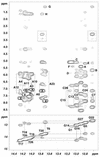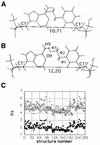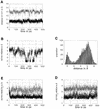The solution structure of an oligonucleotide duplex containing a 2'-deoxyadenosine-3-(2-hydroxyethyl)- 2'-deoxyuridine base pair determined by NMR and molecular dynamics studies
- PMID: 11884635
- PMCID: PMC101359
- DOI: 10.1093/nar/30.6.1371
The solution structure of an oligonucleotide duplex containing a 2'-deoxyadenosine-3-(2-hydroxyethyl)- 2'-deoxyuridine base pair determined by NMR and molecular dynamics studies
Abstract
Determination of the solution structure of the duplex d(GCAAGTC(HE)AAAACG)*d(CGTTTTAGACTTGC) containing a 3-(2-hydroxyethyl)-2'-deoxyuridine*deoxyadenine (HE*A) base pair is reported. The three-dimensional solution structure, determined starting from 512 models via restrained molecular mechanics using inter-proton distances and torsion angles, converged to two final families of structures. For both families the HE and the opposite A residues are intrahelical and in the anti conformation. The hydroxyethyl chain lies close to the helix axis and for one family the hydroxyl group is above the HE*A plane and in the other case it is below. These two models were used to start molecular dynamic calculations with explicit solvent to explore the hydrogen bonding possibilities of the HE*A base pair. The dynamics calculations converge finally to one model structure in which two hydrogen bonds are formed. The first is formed all the time and is between HEO4 and the amino group of A, and the second, an intermittent one, is between the hydroxyl group and the N1 of A. When this second hydrogen bond is not formed a weak interaction CH...N is possible between HEC7H2 and N1A21. All the best structures show an increase in the C1'-C1' distance relative to a Watson-Crick base pair.
Figures








Similar articles
-
Structures of oligonucleotides containing 5-(methoxymethyl)-2'-deoxyuridine determined by NMR spectroscopy.J Biomol Struct Dyn. 1994 Apr;11(5):1017-33. doi: 10.1080/07391102.1994.10508049. J Biomol Struct Dyn. 1994. PMID: 7946057
-
Solution structure of an oligodeoxynucleotide duplex containing the exocyclic lesion 3,N4-etheno-2'-deoxycytidine opposite 2'-deoxyadenosine, determined by NMR spectroscopy and restrained molecular dynamics.Biochemistry. 1996 Oct 15;35(41):13310-8. doi: 10.1021/bi9605696. Biochemistry. 1996. PMID: 8873597
-
NMR solution structure of an oligodeoxynucleotide duplex containing the exocyclic lesion 3,N4-etheno-2'-deoxycytidine opposite thymidine: comparison with the duplex containing deoxyadenosine opposite the adduct.Biochemistry. 1996 Oct 15;35(41):13319-27. doi: 10.1021/bi9605705. Biochemistry. 1996. PMID: 8873598
-
NMR solution structure of a nonanucleotide duplex with a dG mismatch opposite a 10S adduct derived from trans addition of a deoxyadenosine N6-amino group to (+)-(7R,8S,9S,10R)-7,8-dihydroxy-9,10-epoxy-7,8,9,10- tetrahydrobenzo[a]pyrene: an unusual syn glycosidic torsion angle at the modified dA.Biochemistry. 1995 Oct 17;34(41):13570-81. doi: 10.1021/bi00041a037. Biochemistry. 1995. PMID: 7577946
-
Solution structure of a trans-opened (10S)-dA adduct of (+)-(7S,8R,9S,10R)-7,8-dihydroxy-9,10-epoxy-7,8,9,10-tetrahydrobenzo[a]pyrene in a fully complementary DNA duplex: evidence for a major syn conformation.Biochemistry. 2001 May 22;40(20):5870-81. doi: 10.1021/bi002896q. Biochemistry. 2001. PMID: 11352722
Cited by
-
Dynamic conformational states of DNA containing T.T or BrdU.T mispaired bases: wobble H-bond pairing versus cross-strand inter-atomic contacts.J Mol Model. 2005 Mar;11(2):141-59. doi: 10.1007/s00894-005-0238-9. Epub 2005 Feb 18. J Mol Model. 2005. PMID: 15719239
References
-
- Dellarco V.L., Generoso,W.M., Sega,G.A., Fowle,J.R.D. and Jacobson-Kram,D. (1990) Review of the mutagenicity of ethylene oxide. Environ. Mol. Mutagen., 16, 85–103. - PubMed
-
- Ehrenberg L. and Hussain,S. (1981) Genetic toxicity of some important epoxides. Mutat. Res., 86, 1–113. - PubMed
-
- Hogstedt C., Aringer,L. and Gustavsson,A. (1986) Epidemiologic support for ethylene oxide as a cancer-causing agent. J. Am. Med. Assoc., 255, 1575–1578. - PubMed
-
- Stayner L., Steenland,K., Greife,A., Hornung,R., Hayes,R.B., Nowlin,S., Morawetz,J., Ringenburg,V., Elliot,L. and Halperin,W. (1993) Exposure-response analysis of cancer mortality in a cohort of workers exposed to ethylene oxide. Am. J. Epidemiol., 138, 787–798. - PubMed
-
- International Agency for Research on Cancer (IARC) (1985) IARC Monographs on the Evaluation of Carcinogenic Risk of Chemicals to Humans. Allyls Compounds, Aldehydes, Epoxides and Peroxides. Vol. 36. IARC, Lyon, France, pp. 189–226.

